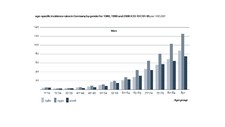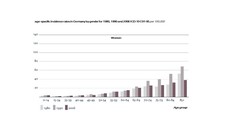-
Topics
subnavigation
Topics
Electromagnetic fields
- What are electromagnetic fields?
- Static and low-frequency fields
- Radiation protection relating to the expansion of the national grid
- Basics transfer of electrical power
- Effects
- Established effects
- Discussed effects of low-frequency fields
- Further environmental effects
- Protection
- High-frequency fields
- Radiation protection in mobile communication
Optical radiation
Ionising radiation
- What is ionising radiation?
- Radioactivity in the environment
- Applications in medicine
- Applications in daily life and in technology
- Effects
- What are the effects of radiation?
- Effects of selected radioactive materials
- Consequences of a radiation accident
- Cancer and leukaemia
- Genetic radiation effects
- Individual radiosensitivity
- Epidemiology of radiation-induced diseases
- Ionising radiation: positive effects?
- Risk estimation and assessment
- Radiation protection
- Nuclear accident management
- Service offers
-
The BfS
subnavigation
The BfS
- About us
- Science and research
- Laws and regulations
- BfS Topics in the Bundestag
- Links
Scientifically discussed effects of low-frequency fields
trong electric and magnetic fields exceeding the existing limit values can lead to health impairments. Whether low-frequency fields could have any further health effects, apart from these established effects, - possibly below the limit values, too - is currently being researched.
Diseases of the nervous system
Some epidemiological studies indicated an increased risk of certain diseases of the nervous system, such as Alzheimer’s disease. This mainly affected individuals who had been exposed to strong low-frequency electric and magnetic fields for occupational reasons. However, not all epidemiological studies showed this association.
Epidemiological studies investigate the distribution of diseases in a population and deal with the factors influencing this distribution. They show statistical correlations which, however, do not necessarily have to mean a causal relationship. Therefore, it is important to complement epidemiological studies by experimental studies, that is, investigations in human subjects, animals or cell cultures.
In the case of nervous system diseases, the findings of epidemiological studies have not yet been confirmed by laboratory investigations. Furthermore, no biological mechanism is currently known that could provide an explanation or scientific evidence for the findings of the studies. However, further scientific research is carried out on the possible association between low-frequency fields and diseases of the nervous system. Studies of this kind are promoted by the BfS.

![]() Leukaemias: age-specific incidence rates for men in Germany for the years 1980, 1990 and 2006
Source: Krebs in Deutschland 2005/2006. Häufigkeiten und Trends. 7. Ausgabe. Robert Koch-Institut (Hrsg) und die Gesellschaft der epidemiologischen Krebsregister in Deutschland e. V. (Hrsg). Berlin, 2010
Leukaemias: age-specific incidence rates for men in Germany for the years 1980, 1990 and 2006
Source: Krebs in Deutschland 2005/2006. Häufigkeiten und Trends. 7. Ausgabe. Robert Koch-Institut (Hrsg) und die Gesellschaft der epidemiologischen Krebsregister in Deutschland e. V. (Hrsg). Berlin, 2010
Cancers in adults
Since the late 1970ies, the question whether low-frequency fields may cause cancers has been investigated. In adults, even with long-term field exposure, no relationship between low-frequency fields and the risk of developing cancer has been established.
Childhood leukaemia
In children, however, several epidemiological studies found an increased risk of developing leukaemia when children were permanently exposed to magnetic fields which were higher than average, but below the exposure limit.
Most of these studies investigated the residential total magnetic field exposure. High-voltage lines near homes can contribute to the exposure. In most housing in Germany the proportion due to high-voltage lines is comparatively small. House wiring and electrical appliances usually make a larger contribution.
The magnetic field exposure value, starting from which an increased risk of leukaemia has been observed, is around 0.3 to 0.4 microtesla (µT) averaged over a day. Such values are rarely found in German households. On average, values for rural areas are below 0.1 microtesla, for urban areas around 0.12 microtesla.

![]() Leukaemias: age-specific incidence rates for women in Germany for the years 1980, 1990 and 2006
Source: Krebs in Deutschland 2005/2006. Häufigkeiten und Trends. 7. Ausgabe. Robert Koch-Institut (Hrsg) und die Gesellschaft der epidemiologischen Krebsregister in Deutschland e. V. (Hrsg). Berlin, 2010
Leukaemias: age-specific incidence rates for women in Germany for the years 1980, 1990 and 2006
Source: Krebs in Deutschland 2005/2006. Häufigkeiten und Trends. 7. Ausgabe. Robert Koch-Institut (Hrsg) und die Gesellschaft der epidemiologischen Krebsregister in Deutschland e. V. (Hrsg). Berlin, 2010
Childhood leukaemia is a rare disease
As only a few children are exposed to magnetic fields above 0.3 microtesla and childhood leukaemia is a comparatively rare disease (about 54 cases per 1,000,000 children under 15 years, that is, 600 newly diagnosed cases per year in Germany), the epidemiological studies are based on a relatively low number of cases. It is all the more important to complement the findings of the epidemiological studies by experimental laboratory studies. To date, however, laboratory studies have not confirmed the findings.
The question whether magnetic fields really contribute to the development of childhood leukaemias is being further investigated. The Federal Office for Radiation Protection encourages further research and provides precautionary recommendations. However, even if a causal relationship could be established, only a small proportion of childhood leukaemia cases would be explained by magnetic field exposure. In general, too little is yet known about the causes of this disease. Here also, further research is needed.
Electromagnetic hypersensitivity
Studies conducted by the BfS have shown that just under two per cent of the German population consider themselves to be electromagnetically hypersensitive. They attribute various complaints, such as headaches, sleep disturbance, fatigue and concentration problems to the presence of electric and magnetic fields in their environment.
For a long time, science has been trying to understand the phenomenon of electromagnetic hypersensitivity. The common conclusion of the numerous studies conducted to date, is that a causal relationship between electric and magnetic fields and the complaints of electromagnetically hypersensitive individuals is highly unlikely. This view is also held, among others, by the World Health Organization (WHO).
State of 2018.02.23


